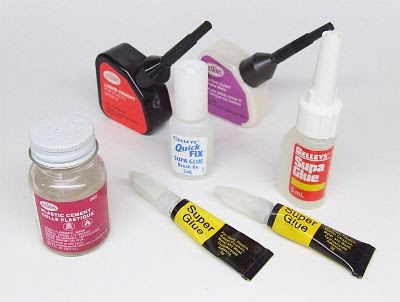No, I don’t mean radio control. I don’t mean those two-stroke motors that seem to be revving at ear-splitting volume in hobby shops every time you go in to find that bottle of paint you need, and I don’t mean the endless shock absorbers, steering gear and offroad tyres that seem to take forever for shop staff to sort out for the people permanently in line ahead, hogging the counter... I’ve nothing against RC, really -- but that’s another post!
No, I mean BIG MODELS. That Dragon or Trumpeter 1:35 Leopold railway gun. Italeri’s new 1:35th scale German Schenllboot. Andrea’s gigantic 1:32nd scale U-boat. Revell’s old B-1 bomber in 1:48th scale. Monogram’s classic 1:72nd scale B-36. Airfix’s 1:24th scale Harrier. Heller’s 1:100th scale sailing ships. And so on...
Is it the mystique of the very large that attracts us? Is it the possibility of acres of minute detail? Is it the childlike thought of having a bigger one than the next modeller? Or is it that some subjects just can’t be done justice to any smaller? The state of modern tooling suggests 1:48th scale is a good benchmark for realism, incorporating a fair detail resolution against the real thing and a general simplicity of construction, so demanding bigger is not necessarily the answer (though consider the detail found on Tamiya’s F-4s in 1:32nd scale... Bigger sometimes is just plain better).
There’s the status aspect. Bigger models are more expensive, and modellers at both an advanced skill level and approaching the rollover time of life are a major part of the target demograph that can actually afford them. (“Do we have to go on that cruise next winter, Martha? I had a hankering for Trumpeter’s 1:16th scale King Tiger...” After which the hobbyist probably slept on the couch.)
But what about really big: those limited-edition monsters that sometimes appear. Of course, I’m thinking about the 80cm K(E), the Dora, the biggest gun ever fired in anger. It first appeared at European toy fairs about four years ago, a 1:35th scale kit initially researched and designed by Heller IIRC, but after the demise of the company it was taken over (if I’m understanding correctly) by an independent firm, and molded in a limited edition of 1000 copies, in China. As a $1000 kit, that’s a million dollars turnover in one property, though it has been permanently discounted to US$700 for the last two years or so. At the present exchange rate, that’s nearly a grand in Australian money. It would take a seriously dedicated hobbyist to square away the funds for that (though to be fair, the cost is still significantly lower than Tamiya’s RC tanks and trucks. In England there is a hobby finance company that loans out funds against them as if you were buying basic transport to get to work.) That brings to mind Tamiya’s RC Tiger 1 and the costs involved, over $1500 Australian some years ago. I remember casting an eye on it longingly and my sister saying “you’ll look ridiculous driving to work in that on Monday.” The implication being you could buy a car for that price.
But does larger scale really mean more detail? It means a different feel, that’s for sure. Compare tanks in 1:72nd, 1:35th and 1:16th scales. Between the first two scales there is a wealth of difference, and it takes a surgeon’s hands to make a 72 -- they don’t call it Braille Scale for nothing -- really look the part. It can be done, there are brilliant mini-masterpieces out there, and better kits than ever before to work with. But 35 seems to be the charm, the perfect balance point at which the techniques that come naturally to hand find their best and simplest expression. Academy have those big 25th scale Panthers and Jagdpanthers, and Tamiya have just reissued their 1:25th scale Tiger and Chieftain, for the first time in something like thirty years (SF modellers will be rubbing their hands as the latter has been fetching US$60 on eBay and is needed for some studio replicas). The AM guys must have thrown prayers of thanks skyward when these kits were re-released, the accessory sets are already hitting the market… 1:16th scale is a new situation completely, in which the delicacy of touch one evolves for 35th generates effects that are almost invisible at a normal viewing distance: one must learn to weather with a broader brush, a heavier hand.
In the end, perhaps it is personal choice, as with every aspect of the hobby. The lifetime 1:72nd scale aircraft builder will fit a lot more of them into a display case than the ship modeller who builds at 1:96th, and the armour modeller who prefers Braille Scale will have far more space and funds than the 1:35th scale builder, but these are practical matters, and the aesthetic of the thing probably ultimately commands the decision. We like what we like, and that’s the end of it. There’s a certain undeniable fascination to palm-top Panzers, but part of me has a hard time taking them seriously.
Of course, it could be simpler... It could be that we start out affording small models and fill shelves with them, and they gradually get bigger as we get older, in proportion to the thickness of our glasses. By the time we retire our eyesight is so shot we have to build the big ones: we have no choice, we just can’t see the teensy ones anymore!
Okay, extracting tongue from cheek... Normal service resumes next post!
Have some links:
Dora ref: http://www.anticsonline.co.uk/673_1_2515675.html
I have the Harrier in my stash and would have photographed those huge parts but it's in a carton on the bottom and I didn't fancy excavating down to find it...

















